

My Place - Home. 100 Years of Change. Then and now Let's explore some of the ways American life has changed in 100 years.
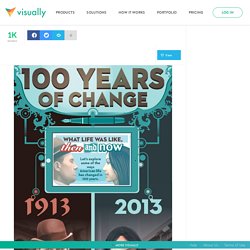
Average individual income Unemployment People per household Median age at first marriage Most popular baby names Boys Girls Boys Girls John Mary Aiden Sophia William Helen Jackson Emma James Dorothy Ethan Olivia Robert Margaret Liam Isabella Joseph Ruth Mason Ava Overall population By ethnicity (percentage of overall population) White 88.8% 63.4% White Black 10.7% 13.1% Black Other 0.5% 23.5% Other races races Life expectancy 2x5= School-aged children enrolled in school High school graduates* Early figures measured 17-year-olds; modern calculation includes up to age 25 Bachelor's degrees* My Grandmother’s Toy Box Activities: Museums Victoria. The story, My Grandmother's Toy Box, has been created to introduce the concepts of continuity and change.

It provides an opportunity for conversations about how toys have changed over time and what has remained recognisable by comparing toys from the past and present. It introduces the concept of a timeline through reference to generations of a family and placing the objects discovered in the toy box against a timeline of the development of Melbourne as a city, using the following questions: How do we know about the past? How do we know what toys children played with in the past? How do we know what games children played in the past? Possible activities to pursue: Read stories about the past – e.g. Some suggestions for discussion of the toys as the story is read: Computer game – Hannah's father's toy What do you think this is? Australian Toys: Museums Victoria. Penny Wooden, circa 1805–1810Image: Rodney StartSource: Museum Victoria Penny Wooden This is one of the oldest dolls in Australia.
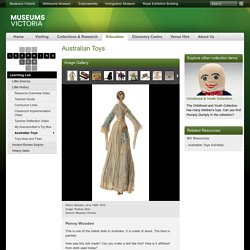
It is made of wood. The face is painted. How was this doll made? Wooden boxed domino set, circa 1860Source: Museum Victoria Domino set. Victoria and Albert Museum. Lone Star Locos...
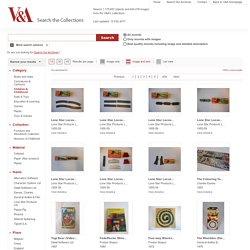
Lone Star Products L... 1955-59 View details Lone Star Locos... View details. What is family? (with subtitles and audio description) Kids vocabulary - Family - family members & tree - Learn English educational video for kids. Types of Family Structures. Source Family structure has changed dramatically over the last 50 years.
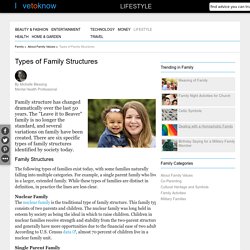
The "Leave it to Beaver" family is no longer the standard, and several variations on family have been created. Family Structure. Family - Australian Museum. Aboriginal and Torres Strait Islander people have a complex system of family relations, where each person knows their kin and their land.
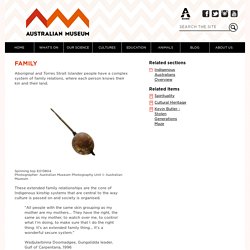
Spinning top E013804 Photographer: Australian Museum Photography Unit © Australian Museum These extended family relationships are the core of Indigenous kinship systems that are central to the way culture is passed on and society is organised. "All people with the same skin grouping as my mother are my mothers... They have the right, the same as my mother, to watch over me, to control what I'm doing, to make sure that I do the right thing. It's an extended family thing... Kinship systems define where a person fits in to the community, binding people together in relationships of sharing and obligation. Australian Institute of Family Studies. Different Types of Families: A Portrait Gallery. Page Content Article Body Nuclear Families Approximately half of all families with youngsters under age 18 are composed of two biological parents and their children.
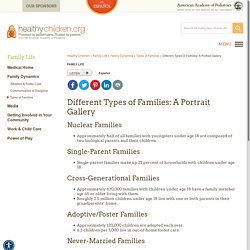
Single-Parent Families Single-parent families make up 27 percent of households with children under age 18. Cross-Generational Families Approximately 670,000 families with children under age 18 have a family member age 65 or older living with them.Roughly 2.5 million children under age 18 live with one or both parents in their grandparents’ home. Adoptive/Foster Families Approximately 120,000 children are adopted each year.6.3 children per 1,000 live in out-of-home foster care. Families - there are many kinds. Family; families; children; stepfamily; foster; mother; father; mum; dad; brother; sister; adopted; child; divorce; stepmother; stepfather. ; Contents A mother, a father and a child?
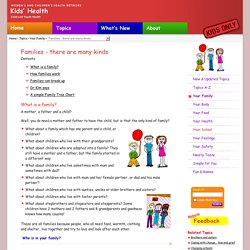
Well, you do need a mother and father to have the child, but is that the only kind of family? What about a family which has one parent and a child, or children? These are all families because people, who all need food, warmth, clothing and shelter, live together and try to love and look after each other. Who are the families of the world. Learning areas History Foundation Who the people in their family are, where they were born and raised and how they are related to each other (ACHHK001)The different structures of families and family groups today, and what they have in common (ACHHK002)How they, their family and friends commemorate past events that are important to them (ACHHK003) Year 1 Differences in family structures and roles today, and how these have changed or remained the same over time (ACHHK028) Year 2 The impact of changing technology on people's lives (at home and in the ways they worked, travelled, communicated, and played in the past) (ACHHK046) English.
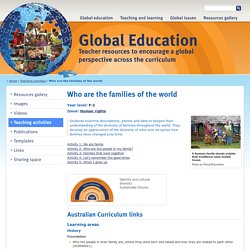
Childfund Connect.